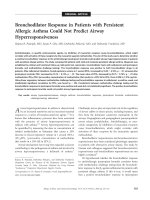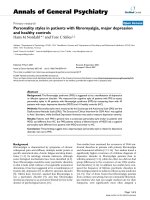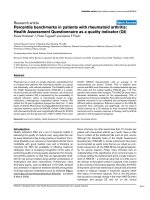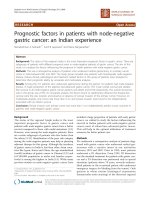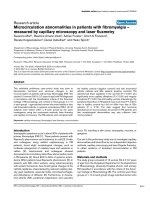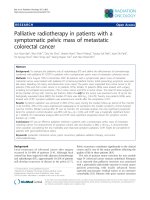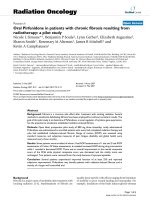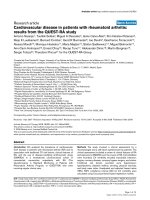Báo cáo y học: "Pituitary-adrenal function in patients with acute subarachnoid haemorrhage: a prospective cohort study" ppsx
Bạn đang xem bản rút gọn của tài liệu. Xem và tải ngay bản đầy đủ của tài liệu tại đây (347.26 KB, 10 trang )
Open Access
Available online />Page 1 of 10
(page number not for citation purposes)
Vol 12 No 5
Research
Pituitary-adrenal function in patients with acute subarachnoid
haemorrhage: a prospective cohort study
Stepani Bendel
1
, Timo Koivisto
2
, Esko Ruokonen
1
, Jaakko Rinne
2
, Jarkko Romppanen
3
,
Ilkka Vauhkonen
4
, Vesa Kiviniemi
5
and Ari Uusaro
1
1
Department of Intensive Care, Kuopio University Hospital and Kuopio University, Puijonlaaksontie 2, 70211 Kuopio, Finland
2
Department of Neurosurgery, Kuopio University Hospital, Puijonlaaksontie 2, 70211 Kuopio, Finland
3
Eastern Finland Laboratory Centre, Kuopio University Hospital, Puijonlaaksontie 2, 70211 Kuopio, Finland
4
Department of Medicine, Kuopio University Hospital and Kuopio University, Puijonlaaksontie 2, 70211 Kuopio, Finland
5
IT Centre, Kuopio University PO Box 1627, 70211, Finland
Corresponding author: Stepani Bendel,
Received: 24 Jun 2008 Revisions requested: 14 Jul 2008 Revisions received: 30 Aug 2008 Accepted: 13 Oct 2008 Published: 13 Oct 2008
Critical Care 2008, 12:R126 (doi:10.1186/cc7084)
This article is online at: />© 2008 Bendel et al.; licensee BioMed Central Ltd.
This is an open access article distributed under the terms of the Creative Commons Attribution License ( />),
which permits unrestricted use, distribution, and reproduction in any medium, provided the original work is properly cited.
Abstract
Introduction Subarachnoid haemorrhage (SAH) may damage
the hypothalamo-pituitary-adrenal gland (HPA) axis and disturb
cortisol metabolism. There are no available data that relates to
the response of the HPA axis in the acute phase of SAH. We
aimed to characterise the behavior of serum adrenocorticotropic
hormone (ACTH), total cortisol, stimulated total cortisol and free
cortisol concentrations in acute aneurysmal SAH.
Methods A prospective cohort study was conducted of patients
with acute aneurysmal SAH (n = 30) admitted to a tertiary
university hospital. Patients admitted for elective aneurysmal
surgery (n = 16) served as the control group. An ACTH
stimulation test was performed twice during the first week and
at three months. The main outcome measure was description of
the ACTH-cortisol response by calculating serum free cortisol
and measuring total cortisol and ACTH concentrations. A mixed
models method was used for testing between the groups,
allowing heterogeneity between the groups.
Results Patients with SAH had higher initial serum total cortisol
(mean +/- SD; 793 +/- 312 nmol/L) and free cortisol
concentrations (83 +/- 55 nmol/L) than control patients (535 +/
- 193 nmol/L, p = 0.001 and 33 +/- 18 nmol/L, p < 0.001,
respectively). Thereafter, there were no differences in this
respect. Serum free and total cortisol concentrations correlated
but were unaffected by the severity of SAH. ACTH
concentrations were comparable between SAH and control
groups. Patients with Hunt-Hess grades IV to V had higher
ACTH concentrations at day one (10.7 +/- 7.1 pmol/l/L) and day
five (8.2 +/- 7.7 pmol/L) than patients with grade I-III (day one:
3.8 +/- 2.0 pmol/L, p = 0.002; day five: 4.7 +/- 1.8 pmol/L, p =
0.04).
Conclusions Calculation of serum free cortisol concentration
was not helpful in identifying patients with potential
hypocortisolism. SAH severity did not affect cortisol
concentrations, possibly indicating relative pituitary-adrenal
insufficiency in patients with more severe bleeding.
Trial registration ClinicalTrials.gov Identifier NCT00614887.
Introduction
Recent studies suggest that disturbed glucocorticoid metab-
olism and adrenal insufficiency may adversely affect outcome
in patients with subarachnoid haemorrhage (SAH) and trau-
matic brain injury (TBI) [1-5]. There is some evidence of a high
incidence of delayed adrenal insufficiency (AI) in patients with
SAH [5-7]. Most studies, however, have focused on TBI, and
there are almost no data on the function of the hypothalamo-
pituitary-adrenal gland (HPA) axis in patients with acute SAH.
ACTH: adrenocorticotropic hormone; AI: adrenal insufficiency; CBG: corticosteroid binding globulin; GCS: Glascow Coma Scale; HDU: high-
dependency unit; HPA: hypothalamo-pituitary-adrenal; ICU: intensive care unit; LOS: length of stay; SAH: subarachnoid haemorrhage; SD: standard
deviation; TBI: traumatic brain injury.
Critical Care Vol 12 No 5 Bendel et al.
Page 2 of 10
(page number not for citation purposes)
In patients with SAH, the HPA axis may be affected by direct
compression of the hypothalamus or pituitary gland by an
aneurysm and/or blood clot. In addition, elevated intracranial
pressure, vasospasm, microinfarctions of the pituitary gland,
venous stasis or surgical procedures may injure these struc-
tures [8]. There is no definition of adequate HPA response in
patients with SAH. For example, cut-off values for AI in
patients with SAH have been derived from other patient pop-
ulations, and therefore these values may not be valid in
patients with SAH. Furthermore, the previous studies have
focused on a single time point after SAH, and the function of
the HPA axis over time has not been investigated. The relation-
ship between serum free versus total cortisol concentrations
is also not known in these patients [8].
The aim of our study was to characterise the function of the
HPA axis acutely and over time for up to three months in
patients with SAH. We used various methods, including serum
free cortisol calculation and measurement of serum total corti-
sol concentration. We also performed testing of adrenocorti-
cotropic hormone (ACTH) and measured ACTH
concentrations over time.
Materials and methods
All patients aged 18 years and older who were scheduled for
elective surgical aneurysm treatment (control group) and all
patients with SAH admitted to the Kuopio University Hospital
in Finland between 29 March and 30 November, 2006, were
prospectively assessed for eligibility for this study. The exclu-
sion criteria for the study were any corticoid treatment (includ-
ing inhaled), use of etomidate before study entry or during the
study period, unknown exact bleeding day, previous history of
SAH, bleeding from more than three days before inclusion,
traumatic SAH, known pituitary insufficiency, and/or a mori-
bund state of the patient. Only surgical patients were enrolled
into the control group because the prescheduled hospital stay
for patients with embolised aneurysms was too short. The hos-
pital ethics committee approved the study protocol, and
informed written consent was received from the patients or
their next of kin.
Patients with subarchnoid haemorrhage
The following blood samples were collected from the first to
the seventh morning after bleeding: serum (s) cortisol (refer-
ence value = 170 to 540 nmol/L), s-corticoid-binding globulin
(s-CBG) (reference value male = 22 to 55 g/L; reference
value female = 40 to 154 g/L) and s-albumin (reference value
= 36 to 45 g/L). Also, samples for ACTH analysis (reference
value = 0 to 11 pmol/L) were collected on the first and seventh
days. An ACTH-stimulating test (250 g of tetracosactide
(Synachten, Ciba-Geigy, France) administered intravenously)
was performed on the first morning in the intensive care unit
(ICU) and seven days after the bleeding. On the second and
sixth days in the ICU, 24-hour urinary cortisol excretion (refer-
ence value = 100 to 380 nmol) was measured.
Control patients
Blood samples were collected from control patients that were
equivalent to those collected from the patients with SAH. The
second ACTH sample was collected on day five. The first cor-
tisol samples were drawn and an ACTH test was performed on
day one before surgery and on day five postoperatively, and
then patients were discharged. On day two, 24-hour urinary
cortisol excretion was measured.
Follow up at three months
At the scheduled three-month follow-up visit, serum total cor-
tisol concentration was measured and free cortisol concentra-
tion was calculated at 9 am, followed by an ACTH-stimulation
test performed in both groups.
Samples for serum free cortisol calculation were stored at -
70°C for later analysis. The same personnel performed all anal-
yses in one laboratory at the Kuopio University Hospital. We
used electrochemiluminescence immunoassay (Elecsys Corti-
sol, Roche Diagnostics, Mannheim, Germany) as the diagnos-
tic method. The Coolens method was used to calculate serum
free cortisol concentration [9]: U
2
K (1 + N) + U [1 + N + K (G
- T)] - T = 0, where K= 3 × 10
-7
M
-1
(affinity of CBG) to cortisol
at 37°C, G = CBG, U = unbound cortisol, T = cortisol, and N
= ratio of albumin bound to free cortisol (1.74). U was calcu-
lated as follows: , where
Serum CBG concentrations were analysed with radioimmu-
noassay (BioSource Europe S.A., Nivelles, Belgium). After
dichloromethane extraction, urinary free cortisol concentra-
tions were analysed using the same method employed for
serum total cortisol measurement. Plasma ACTH concentra-
tions were analysed using an immunoluminometric assay
(IMMULITE; Diagnostic Products Corporation, Los Angeles,
CA).
Several serum cortisol concentration cut-off values for AI have
been published. We used a random serum total cortisol con-
centration of less than 500 nmol/L to indicate AI [10,11]. For
free cortisol, we used a concentration of less than 55 nmol/L
as the cut-off for risk of AI [12]. We also tried to find out
patients from our study population with low serum total (less
than 350 nmol/L) and/or free cortisol concentrations (less
than 22 nmol/L) and low serum ACTH concentrations (less
than 5 pmol/L) to search for those at risk of secondary AI [11].
In addition, a total cortisol response less than 248 nmol/L to
exogenous 250 g ACTH [13] was used as a marker for rela-
tive AI.
UZ Z
T
NK
=+ −
+
()
2
1
Z
K
GT
N
=+
−
+
()
1
2
21
Available online />Page 3 of 10
(page number not for citation purposes)
Statistical methods
We used a power of 80% and a two-sided -level of 0.05 in
sample size calculations. We assumed that 25% of patients
with SAH and none of the elective surgical patients would
develop AI [14], and decided to recruit 30 patients with SAH
and 30 control patients.
Data are presented as mean ± standard deviation (SD) or as
absolute values and percentages or medians and interquartile
ranges. Distribution of the parameters was assessed by the
Kolmogorov-Smirnov test. For normally distributed parame-
ters, student's t-tests were used to compare the means of dif-
ferent groups. The Mann-Whitney U test was used for
nonparametric testing between the groups. A mixed models
method was used for testing between the groups, allowing
heterogeneity between the groups.
Spearman or Pearson correlations were calculated. SPSS
14.0 software (SPSS, Chicago, IL) was used to perform the
analyses.
Results
Thirty patients with SAH and 16 control patients assessed for
elective cerebral aneurysm operations were enrolled into the
study (Figures 1a and 1b). Recruitment was very slow
because of the frequent choice of endovascular aneurysm
treatment and high rate of exclusion for other reasons, and we
were unable to enroll the planned 30 surgical patients into the
control group. Seventeen patients with SAH underwent
endovascular treatment and 13 patients had open surgery.
The mean length of stay (LOS) for patients with SAH was 97
± 100 hours at the ICU and 34 ± 51 hours at the high-depend-
ency unit (HDU). Patients in the control group had an LOS in
the HDU of 22 ± 2 hours. Patients with SAH had a hospital
LOS of 14.6 ± 5.4 days and patients in the control group had
a hospital LOS of 8 ± 3 days (p < 0.001). The three-month
Figure 1
Flow chart of patients with (a) subarchnoid haemorrhage (SAH) and (b) control patientsFlow chart of patients with (a) subarchnoid haemorrhage (SAH) and (b) control patients.
Critical Care Vol 12 No 5 Bendel et al.
Page 4 of 10
(page number not for citation purposes)
mortality was 10% in patients with SAH and none of the
patients in the control group died. Demographic data for the
patients are presented in Table 1.
Serum total and free cortisol concentrations are presented in
Figure 2. In the control patients, the mean random serum total
cortisol concentrations were 535 ± 193 nmol/L at day one,
666 ± 244 nmol/L at day two, 571 ± 224 nmol/L at day three,
641 ± 261 nmol/L at day four, 534 ± 178 nmol/L at day five
and 517 ± 185 nmol/L at three months. The mean random
serum free cortisol concentrations were 33 ± 18 nmol/L at day
one, 61 ± 48 nmol/l at day two, 46 ± 33 nmol/L at day three,
49 ± 36 nmol/L at day four, 34 ± 18 nmol/L at day five and 31
± 17 nmol/l at three months.
In the patients with SAH, the mean random serum total cortisol
concentrations were 793 ± 312 nmol/L at day one, 736 ± 320
nmol/L at day two, 679 ± 271 nmol/L at day three, 620 ± 258
nmol/L at day four, 596± 262 nmol/L at day five and 454 ±
124 nmol/L at three months. The mean random serum free cor-
tisol concentrations were 83 ± 55 nmol/L at day one, 74 ± 57
nmol/L at day two, 63 ± 44 nmol/L at day three, 44 ± 24 nmol/
L at day four, 46 ± 40 nmol/l at day five and 24 ± 9 nmol/L at
three months.
The dependence of free cortisol on total cortisol (Figure 3)
shows the expected hyperbolic increase of free cortisol with
total cortisol, until CBG is saturated, when the relation
becomes linear. There was a good correlation between serum
total and free cortisol concentration at day one (r = 0.66, p <
0.001), day three (r = 0.9, p < 0.001), day five (r = 0.886, p <
0.001) and three months (r = 0.75, p < 0.001) (Figure 3).
The percentages of patients whose serum total cortisol con-
centration was less than 500 nmol/L or with a serum free cor-
tisol concentration less than 55 nmol/L are presented in Figure
4.
There was a significant difference between control patients
and patients with SAH at day one in serum total (p = 0.001)
and free (p = 0.001) cortisol concentrations. There was no dif-
Table 1
Demographic data of the patients
SAH (n = 30) Control (n = 16) p value
Age, years (range) 52 (21 to 78) 50 (37 to 64) 0.53
Gender M/F 14/16 4/12 0.15
Aneurysm location
ICA 6 6
MCA 8 10
AcoA 11 0
ACA distal 2 0
VBA 3 0
Hydrocephalus at admission 6 0
Fisher grade
16
I to II 4
III to IV 26
Hunt-Hess initial
15
I to II 15
III 6
IV to V 9
SAPS II 30 ± 13
APACHE II 15 ± 6
Data are presented as numbers or mean ± standard deviation unless otherwise indicated. ACA = anterior cerebral artery; AcoA = anterior
communicating artery; APACHE = Acute Physiology and Chronic Health Evaluation; HDU = high dependency unit; ICA = internal carotid artery;
ICU = intensive care unit; LOS = length of stay; MCA = median cerebral artery; SAH = subarachnoid haemorrhage; SAPS = Simplified Acute
Physiology Score. VBA = vertebro basilar artery.
Available online />Page 5 of 10
(page number not for citation purposes)
ference in serum total or free cortisol concentrations through
the study period in patients with SAH divided into groups with
GCS at the first 24 hours of less than eight (n = 9) or more
than eight. The cortisol concentrations also did not differ
between patients who required (n = 9) or did not require
noradrenaline due to symptomatic vasospasm and/or cerebral
perfusion pressure maintenance. Hydrocephalus at admission
(n = 6) or hypoalbuminea (< 25 g/L) (n = 8) did not affect
serum free or total cortisol concentrations in patients with
SAH. In addition, patients with SAH and a serum albumin of
either less than 25 g/L or more than 25 g/L had equal free/
total cortisol concentration ratios. Bleeding severity according
to Hunt-Hess grade [15] did not affect serum free or total cor-
tisol concentrations. There was neither any difference in the
serum free or total cortisol concentrations if the patients had
hyponatraemia (p-natrium < 130 mmol/L) at any time during
the study. No patient had sepsis. Control patients received
cloxacillin twice at the first day. Patients with SAH received
cloxacillin for prophylaxis if they had intraventricular pressure
monitoring.
At day one, patients with SAH had an ACTH concentration of
5.3 ± 4.7 pmol/L; in the control patients, the concentration
was 4.4 ± 2.2 pmol//L (p = 0.88). At day seven, the ACTH
concentration was 5.6 ± 4.2 pmol/L in patients with SAH and
4.4 ± 1.3 pmol/L at day five in the control group (p = 0.43).
Figure 2
Serum free and total cortisol concentrationsSerum free and total cortisol concentrations. Patients with subarchnoid haemorrhage (SAH) had higher initial (a) serum total cortisol (p = 0.001)
and (b) free cortisol concentrations (p < 0.001) than control patients. At later time points, there were no differences between the groups in this
respect. Data are presented as median, interquartile ranges and outliers.
Critical Care Vol 12 No 5 Bendel et al.
Page 6 of 10
(page number not for citation purposes)
Serum ACTH correlated with serum free cortisol concentra-
tion at day one (r = 0.32, p = 0.045). Otherwise serum total or
free cortisol concentrations did not correlate with serum
ACTH concentration. There were two patients with SAH who
had low serum total cortisol concentrations (122 nmol/L and
303 nmol/L) and low serum free cortisol concentrations (7
nmol/L and 21 nmol/L) combined with low ACTH
concentrations (3.08 pmol/L and 2.2 pmol/L) at the first day:
they both had normal values afterwards. The other patient of
these two also failed the three-month ACTH test (ACTH-
response < 248 nmol/l).
After one week there were two patients with low serum total
cortisol concentrations (254 nmol/L and 335 nmol/L) and low
serum free cortisol concentrations (14 nmol/L and 14 nmol/L)
with a combination of low serum ACTH concentrations (2.64
pmol/L and 2.2 pmol/L). Additionally there were two patients
with isolated low serum free cortisol concentrations (20 nmol/
L and 21 nmol/L) and normal total cortisol concentrations
(573 nmol/L and 474 nmol/L) but low ACTH concentrations
(4.4 pmol/L and 3.5 pmol/L).
Treatment modality or aneurysm location (anterior communi-
cating artery versus other artery) did not affect serum ACTH or
free or total cortisol concentrations. Patients with Hunt-Hess
grades IV to V had higher ACTH concentrations at days one
(10.7 ± 7.1 pmol/L) and five (8.2 ± 7.7 pmol/L) than patients
with Hunt-Hess grades I to III (day one:3.8 ± 2.0 pmol/L, p =
0.002; day five: 4.7 ± 1.8 pmol/L, p = 0.04). GCS (< 8 or >
8), Fisher grade [16] (I-II versus III-IV), or presence of hydro-
cephalus did not affect ACTH concentrations.
Figure 5 illustrates the response to exogenous ACTH (ACTH
stimulation test). At day one, eight (33%) patients with SAH
and eight (50%) control patients had a cortisol response less
than 248 nmol/L (p = 0.11). At day five and at three months,
one patient with SAH and no control patients had a cortisol
response less than 248 nmol/L (neither was significant). The
patient with a failed synachten test at three months also failed
the first and second test. The 24-hour urinary free cortisol con-
centration was 4896 ± 5342 nmol/L in patients with SAH and
1641 ± 1601 nmol/L in the control group at day two (p =
0.001). At day six, the urinary 24-hour free cortisol concentra-
tion was 3276 ± 3710 nmol/L in patients with SAH. The evo-
lution of CBG concentration is presented in Figure 6.
Discussion
According to our study, SAH causes an HPA axis response
similar to that of elective cranial aneurysm surgery. The severity
of SAH does not affect serum free or total cortisol concentra-
tions, which could potentially reflect relative AI in patients with
more severe SAH. We also found a good correlation between
serum free and total cortisol concentrations; therefore calcula-
tion of serum free cortisol may not offer any advantage in the
clinical setting.
One of the major stress responses to trauma is the activation
of the HPA axis to increase cortisol production. SAH may dis-
turb the function of the HPA axis by brain swelling, microinfarc-
tions, venous stasis, surgical manipulation or hypoperfusion of
the brain [8]. Some data suggest delayed insufficiency of the
HPA axis after SAH [5,17,18]. Little is known of the cortisol-
secretion dynamics in the very acute phase in SAH or about
the function of the whole HPA axis over time in patients with
SAH. Studies in acute neurosurgical patients include only a
very few patients with SAH and predominantly patients with
TBI [19,20]. Additionally, some patients in previous studies
had received glucocorticoid treatment [21]or only a single
time point was investigated [19]. However, we could not dem-
onstrate any difference in the behaviour of serum total cortisol
concentrations between patients with SAH and patients in the
control group. Furthermore, although open aneurysm surgery
was supposed to cause a clearer elevation of serum cortisol
concentrations than endovascular treatment, we did not
observe any difference in the HPA function between patients
with surgical and endovascular treatment of their ruptured
aneurysms. Neither were we able to show any difference in the
adrenal response between comatose (GCS < 8) and noncom-
atose patients. This indicates that adrenal response may be
inadequate, that is it may be insufficient in the comatose and
therefore more severely ill patients.
We are not aware of other studies that provide calculation of
serum free cortisol concentration in patients with SAH. Corti-
sol is bound about 90% to CBG and albumin, and only the
unbound free fraction is responsible for the physiological
effects. By measuring CBG, it is possible to obtain the serum
Figure 3
Pooled data and quadratic regression analysisPooled data and quadratic regression analysis. Equation from quad-
ratic regression analysis for serum free cortisol concentration = 0.024
× serum total cortisol concentration + 0.0000772 × total cortisol
concentration
2
. Pearson correlation coefficient 0.88, p < 0.001.
Available online />Page 7 of 10
(page number not for citation purposes)
free cortisol concentration using the Coolens' method [9]
which has been shown to be reliable in ICU patients [22].
CBG has a low capacity and high affinity for cortisol and it
becomes saturated at a serum cortisol concentration of about
690 nmol/L [11]. This is seen in Figure 3 as a change in the
slope of the correlation lines. Any alterations in plasma albumin
and CBG concentration may affect the relationship between
serum free and total cortisol concentrations; however, this is
not seen in Figure 3 as the majority of the data follow a similar
trend. This is to be expected as CBG concentrations are not
grossly affected in SAH (Figure 6).
It has also been suggested that serum albumin may affect test-
ing of adrenal function in critically ill patients [12]. We found
that calculation of serum free cortisol concentration was not
more informative than measurement of serum total cortisol
concentrations. Furthermore, we did not see any difference in
serum free or total cortisol concentrations in hypoalbumenic
versus other patients. Neither did we observe any difference in
CBG concentration in hypoalbumenic patients as compared
with patients with an albumin concentration more than 25 g/L.
This finding is in accordance with those of a previous study by
Ho and colleagues in which they found that adjustment of the
Coolens' equation constant to albumin concentration had only
a minimal effect on estimated serum free cortisol [22].
ACTH concentrations were higher in patients with Hunt-Hess
grades IV to V compared with patients with Hunt-Hess grades
I to III. It remains unclear if the ACTH response is sufficient or
if the adrenal gland responds adequately to ACTH. The
adrenal gland response is likely to be unaffected because the
cortisol response to exogenous ACTH was adequate. It is pos-
sible that SAH already causes ACTH deficiency and second-
ary AI in the acute phase of bleeding and some studies
suggest that this may last years after the primary ictus present
[5,17]. As an indication of this, we found patients with SAH
who had low serum free or total cortisol concentrations and
low ACTH concentrations reflecting possible secondary AI.
Figure 4
Percentage of patients with baseline serum free cortisol concentration less than 55 nmol/L or serum total cortisol concentration less than 500 nmol/LPercentage of patients with baseline serum free cortisol concentration less than 55 nmol/L or serum total cortisol concentration less than
500 nmol/L. * = difference between the groups at day one, p = 0.046. ** = difference between the groups at day one, p < 0.001.
Critical Care Vol 12 No 5 Bendel et al.
Page 8 of 10
(page number not for citation purposes)
We found no correlation between serum ACTH concentration
and serum free or total cortisol concentrations. This finding is
not in accordance with that of Tanriverdi and colleagues [23]
who identified a correlation between serum cortisol and ACTH
concentration with measures at a single time point only. It must
be remembered that in stress situations there is also non-
ACTH-mediated cortisol secretion caused by inflammatory
cytokines for example [24]. Medication of the patients may
affect cortisol secretion as well [3]. Patients in the present
study did not receive any etomidate.
Critically ill patients who have relative adrenal insufficiency
confirmed by the ACTH-stimulation test may benefit from cor-
tisol-substitution therapy [25]. We observed similar inci-
dences of adrenal insufficiency in both the patients with SAH
and the control group when the ACTH-stimulation test was
performed repeatedly. In critically ill patients, the value of
ACTH testing has recently been questioned [26], especially
the value of this test in detecting AI at high baseline cortisol
concentration which might tell us of an exhausted adrenal
gland rather than real adrenal insufficiency. This test may not
be reliable for detecting adrenal insufficiency in critically ill
patients, and confounding factors influence the method by
which cortisol is analysed [27,28]. Despite our efforts, it
remains unclear whether the HPA axis response in patients
with SAH is adequate.
There are several different classifications and diagnostic crite-
ria for detecting AI and they differ in sensitivity and specificity
[29]. These criteria are based either on random serum total
cortisol concentration [10,30] or on the ACTH-stimulation test
[13]. Depending on the criteria used, the incidence of AI varies
widely, as it does, for example, in patients with TBI [4]. It is
noteworthy, however, that the diagnostic criteria have been
Figure 5
Response to exogenous adrenocorticotropic hormone (ACTH) in patients with subarachnoid haemorrhage (SAH) and control patientsResponse to exogenous adrenocorticotropic hormone (ACTH) in patients with subarachnoid haemorrhage (SAH) and control patients.
There were no statistically significant differences between the groups. The percentage of patients with a serum cortisol response less than 248
nmol/L also was not different between the groups. Test one = day one; test two = day five (control) and day seven (SAH); test three = three months.
Data are presented as median, interquartile ranges and outliers.
Available online />Page 9 of 10
(page number not for citation purposes)
derived from studies on patients who do not have acute intrac-
ranial pathology. Specifically, there are no studies that focus
on the acute phase of SAH. Hence, the definitions for HPA
axis deficiency are not available for these patients. In our study,
the incidence of adrenal insufficiency in SAH varied between
17% and 50% depending on the different existing definitions
used for critically ill patients in general. In this respect, we did
not find any difference in AI between patients with SAH or
control patients. Despite recent suggestions, our findings indi-
cate that it is premature to recommend glucocorticoid treat-
ment for patients with SAH [8]. For example, we found much
higher 24-hour urinary free cortisol concentrations in patients
with SAH compared with control patients, which could sup-
port an assumption of the presence of adequate cortisol
dynamics.
There are some limitations in our study. Although we used ver-
satile methods to investigate the HPA axis response over time,
we could not evaluate the period between one week and three
months. To choose another control group, for example septic
or trauma patients, would have caused numerous additional
confounding factors including corticoid therapy, infections
and repeated operations. We were also unable to recruit as
many patients into the control group as we originally planned.
Our study was not powered for subgroup analysis. In addition,
the number of patients with severe bleeding was limited, which
could potentially have affected our results.
Conclusions
For the first time the function of the HPA axis in patients with
acute SAH was characterised over time, up to three months,
using various methods. Our findings suggest that SAH causes
a rapid cortisol response, but whether this response is ade-
quate in more severely ill patients remains unclear. The clinical
picture of our patients does not support AI in patients with
SAH. Calculation of serum free cortisol concentrations does
not seem to be helpful in assessing adrenal function in patients
with SAH.
Competing interests
This study was supported in part, by academic grants from
Maire Taponen Foundation, Helsinki, Finland and Kuopio Uni-
versity Hospital Grant, Kuopio, Finland. The authors declare
that they have no competing interests.
Authors' contributions
SB, AU and TK participated in study conception, acquisition of
data, analysis and interpretation of data, drafting the
manuscript and critically revising it. ER participated in study
conception, analysis and interpretation of data, drafting the
manuscript and critically revising it. JRI and IV participated in
study conception, manuscript drafting and critically revising it.
JRO participated in analysis and interpretation of data, drafting
the manuscript and critically revising it. VK participated in
analysis and interpretation of data and in revising the critically
manuscript.
References
1. Agha A, Phillips J, O'Kelly P, Tormey W, Thompson CJ: The natu-
ral history of post-traumatic hypopituitarism: Implications for
assessment and treatment. Am J Med 2005, 118:1416.
2. Agha A, Rogers B, Mylotte D, Taleb F, Tormey W, Phillips J,
Thompson CJ: Neuroendocrine dysfunction in the acute phase
of traumatic brain injury. Clin Endocrinol (Oxf) 2004,
60:584-591.
3. Cohan P, Wang C, McArthur DL, Cook SW, Dusick JR, Armin B,
Swerdloff R, Vespa P, Muizelaar JP, Cryer HG, Christenson PD,
Kelly DF: Acute secondary adrenal insufficiency after traumatic
brain injury: A prospective study. Crit Care Med 2005,
33:2358-2366.
Figure 6
Evolution of corticoid-binding globulin (CBG) concentration in patients with subarachnoid haemorrhage (SAH) and control patientsEvolution of corticoid-binding globulin (CBG) concentration in
patients with subarachnoid haemorrhage (SAH) and control
patients. There were no between-group differences, but CBG concen-
tration changed significantly over time in both groups, p = 0.008. Data
are presented as mean ± standard deviation.
Key messages
• This is the first study to investigate adrenal function in patients with clearly defined acute aneurysmal SAH
• Severe SAH causes various rises in cortisol and ACTH; some patients have values that could be inappropriate for the
amount of stress sustained
• Calculation of serum free cortisol is not helpful in assessing adrenal function in SAH
• More studies are needed to define normal HPA response in acute SAH
Critical Care Vol 12 No 5 Bendel et al.
Page 10 of 10
(page number not for citation purposes)
4. Bernard F, Outtrim J, Menon DK, Matta BF: Incidence of adrenal
insufficiency after severe traumatic brain injury varies accord-
ing to definition used: Clinical implications. Br J Anaesth 2006,
96:72-76.
5. Dimopoulou I, Kouyialis AT, Tzanella M, Armaganidis A, Thalassi-
nos N, Sakas DE, Tsagarakis S: High incidence of neuroendo-
crine dysfunction in long-term survivors of aneurysmal
subarachnoid hemorrhage. Stroke 2004, 35:2884-2889.
6. Kreitschmann-Andermahr I, Hoff C, Niggemeier S, Pruemper S,
Bruegmann M, Kunz D, Matern S, Gilsbach JM: Pituitary defi-
ciency following aneurysmal subarachnoid haemorrhage. J
Neurol Neurosurg Psychiatry 2003, 74:1133-1135.
7. Aimaretti G, Ambrosio MR, Di Somma C, Fusco A, Cannavo S,
Gasperi M, Scaroni C, De Marinis L, Benvenga S, degli Uberti EC,
Lombardi G, Mantero F, Martino E, Giordano G, Ghigo E: Trau-
matic brain injury and subarachnoid haemorrhage are condi-
tions at high risk for hypopituitarism: Screening study at 3
months after the brain injury. Clin Endocrinol (Oxf) 2004,
61:320-326.
8. Schneider HJ, Kreitschmann-Andermahr I, Ghigo E, Stalla GK,
Agha A: Hypothalamopituitary dysfunction following traumatic
brain injury and aneurysmal subarachnoid hemorrhage: A sys-
tematic review. JAMA 2007, 298:1429-1438.
9. Coolens JL, Van Baelen H, Heyns W: Clinical use of unbound
plasma cortisol as calculated from total cortisol and corticos-
teroid-binding globulin. J Steroid Biochem 1987, 26:197-202.
10. Marik PE, Zaloga GP: Adrenal insufficiency during septic shock.
Crit Care Med 2003, 31:141-145.
11. Aron DC, Findling JW, Tyrrell JB: Glucocorticoids & adrenal
androgens. In Basic & Clinical Endocrinology 8th edition. Edited
by: Greenspan FS, Gardner DG. United States: Lange;
2007:346-389.
12. Hamrahian AH, Oseni TS, Arafah BM: Measurements of serum
free cortisol in critically ill patients. N Engl J Med 2004,
350:1629-1638.
13. Annane D, Sebille V, Troche G, Raphael JC, Gajdos P, Bellissant
E: A 3-level prognostic classification in septic shock based on
cortisol levels and cortisol response to corticotropin. JAMA
2000, 283:1038-1045.
14. Dimopoulou I, Tsagarakis S: Hypothalamic-pituitary dysfunction
in critically ill patients with traumatic and nontraumatic brain
injury. Intensive Care Med 2005, 31:1020-1028.
15. Hunt WE, Hess RM: Surgical risk as related to time of interven-
tion in the repair of intracranial aneurysms. J Neurosurg 1968,
28:14-20.
16. Fisher CM, Kistler JP, Davis JM: Relation of cerebral vasospasm
to subarachnoid hemorrhage visualized by computerized
tomographic scanning. Neurosurgery 1980, 6:1-9.
17. Dimopoulou I, Tsagarakis S, Douka E, Kouyialis AT, Dafni U, Tha-
lassinos N, Roussos C: The low-dose corticotropin stimulation
test in acute traumatic and non-traumatic brain injury: Inci-
dence of hypo-responsiveness and relationship to outcome.
Intensive Care Med 2004, 30:1216-1219.
18. Kreitschmann-Andermahr I, Hoff C, Saller B, Niggemeier S, Pruem-
per S, Hutter BO, Rohde V, Gressner A, Matern S, Gilsbach JM:
Prevalence of pituitary deficiency in patients after aneurysmal
subarachnoid hemorrhage. J Clin Endocrinol Metab 2004,
89:4986-4992.
19. Savaridas T, Andrews PJ, Harris B: Cortisol dynamics following
acute severe brain injury. Intensive Care Med 2004,
30:1479-1483.
20. Kelly DF, Gonzalo IT, Cohan P, Berman N, Swerdloff R, Wang C:
Hypopituitarism following traumatic brain injury and aneurys-
mal subarachnoid hemorrhage: a preliminary report. J
Neurosurg 2000, 93:743-752.
21. Espiner EA, Leikis R, Ferch RD, MacFarlane MR, Bonkowski JA,
Frampton CM, Richards AM: The neuro-cardio-endocrine
response to acute subarachnoid haemorrhage. Clin Endocri-
nol (Oxf) 2002, 56:629-635.
22. Ho JT, Al-Musalhi H, Chapman MJ, MacFarlane MR, Bonkowski JA,
Frampton CM, Richards AM: Septic shock and sepsis: a com-
parison of total and free plasma cortisol levels. J Clin Endocri-
nol Metab 2006, 91:105-114.
23. Tanriverdi F, Dagli AT, Karaca Z, Unluhizarci K, Selcuklu A,
Casanueva FF, Kelestimur F: High risk of pituitary dysfunction
due to aneurysmal subarachnoid haemorrhage: a prospective
investigation of anterior pituitary function in the acute phase
and 12 months after the event. Clin Endocrinol (Oxf) 2007,
67:931-937.
24. Chrousos GP: The hypothalamic-pituitary-adrenal axis and
immune-mediated inflammation. N Engl J Med 1995,
332:1351-1362.
25. Annane D, Sebille V, Charpentier C, Bollaert PE, Francois B,
Korach JM, Capellier G, Cohen Y, Azoulay E, Troche G, Chaumet-
Riffaut P, Bellissant E: Effect of treatment with low doses of
hydrocortisone and fludrocortisone on mortality in patients
with septic shock. JAMA 2002, 288:862-871.
26. Sprung CL, Annane D, Keh D, Moreno R, Singer M, Freivogel K,
Weiss YG, Benbenishty J, Kalenka A, Forst H, Laterre PF, Reinhart
K, Cuthbertson BH, Payen D, Briegel J: Hydrocortisone therapy
for patients with septic shock. N Engl J Med 2008,
358:111-124.
27. Klose M, Lange M, Rasmussen AK, Hilsted L, Haug E, Andersen
M, Feldt-Rasmussen U: Factors influencing the adrenocortico-
tropin test: role of contemporary cortisol assays, body compo-
sition, and oral contraceptive agents. J Clin Endocrinol Metab
2007, 92:1326-1333.
28. Cohen J, Ward G, Prins J, Jones M, Venkatesh B: Variability of
cortisol assays can confound the diagnosis of adrenal insuffi-
ciency in the critically ill population. Intensive Care Med 2006,
32:1901-1905.
29. Dorin RI, Qualls CR, Crapo LM: Diagnosis of adrenal
insufficiency. Ann Intern Med 2003, 139:194-204.
30. Cooper MS, Stewart PM: Corticosteroid insufficiency in acutely
ill patients. N Engl J Med 2003, 348:727-734.

